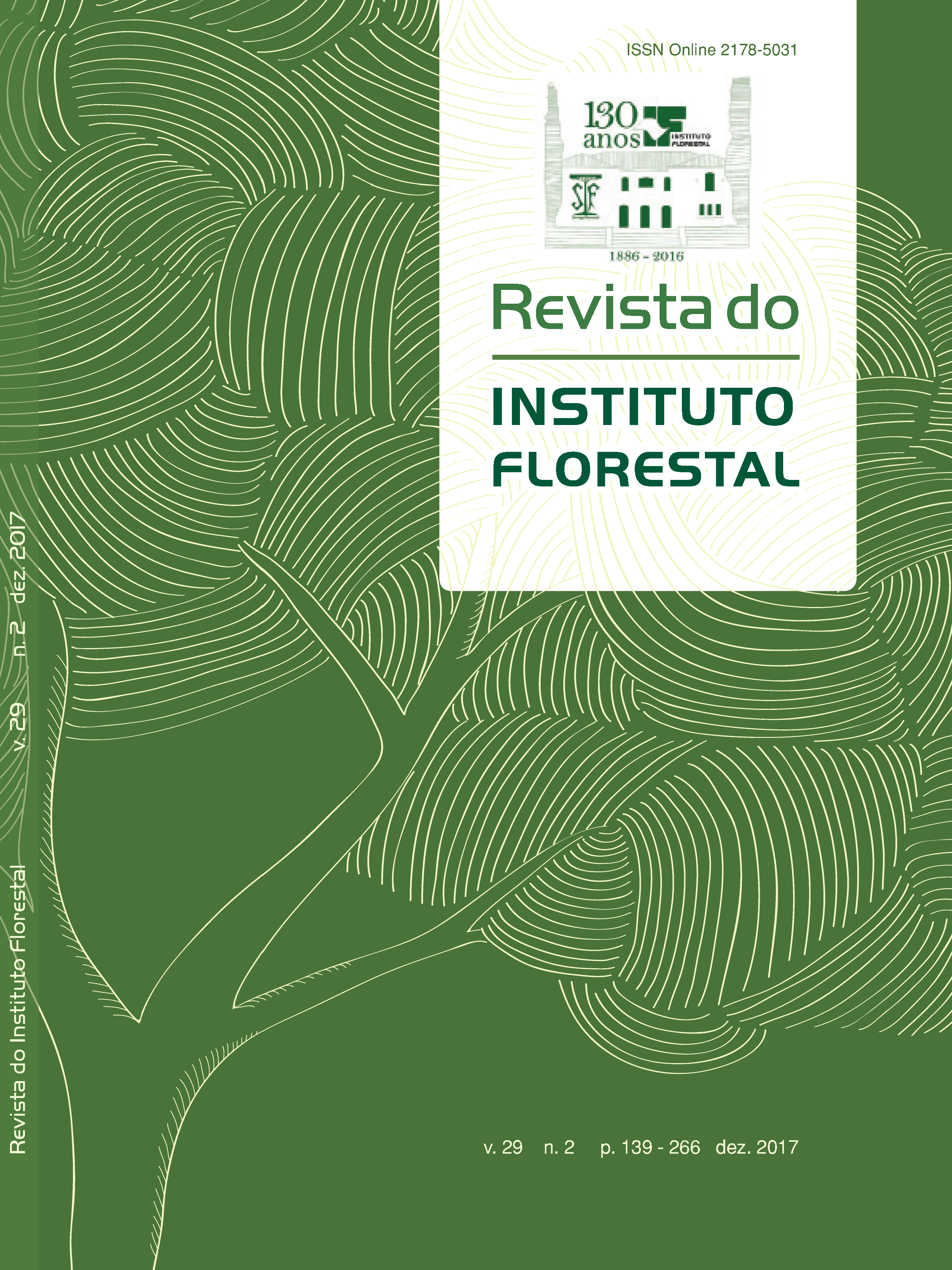VARIABILIDADE GENÉTICA EM CLONES DE Eucalyptus spp. PARA GRAJAÚ, ESTADO DO MARANHÃO
DOI:
https://doi.org/10.24278/2178-5031.201729209Palavras-chave:
melhoramento florestal, parâmetros genéticos, herdabilidades, correlaçãoResumo
Esta pesquisa teve por objetivo a seleção de clones de eucaliptos em teste em Grajaú-MA, Brasil, visando ao aumento na produtividade. Os caracteres avaliados foram diâmetro à altura do peito – DAP (cm) e altura – ALT (m). Para isto, um total de 130 clones, distribuídos em 20 blocos, com uma planta/parcela, foram mensurados aos quatro e cinco anos. Os procedimentos estatísticos foram o método do modelo misto para obter o melhor preditor linear não viesado (BLUP) e a máxima verossimilhança restrita (REML) para estimar os componentes de variância. Para clones e parcelas, os testes de razão de verossimilhança (LRT) foram significativos a 1% de probabilidade. A variabilidade genética foi alta e variou de 11,42% a 14,70% para DAP e 9,15% a 10,22% para ALT. Os coeficientes de variação relativa (CVr) foram maiores que um para ambos os caracteres, mostrando que a seleção pode resultar em grandes e rápidos ganhos genéticos. No geral, os caracteres foram altamente acurados. As correlações genéticas ( rˆg) foram positivas, indicando a possibilidade de seleção indireta. Os resultados indicaram que o DAP deve ser usado preferencialmente em relação à ALT, e permitem concluir que os ganhos genéticos após a seleção são muito promissores. Os clones selecionados podem ser indicados para testes clonais piloto e/ou fase II em locais com condições ambientais similares às do local de teste.
Downloads
Referências
ANDRADE, M.C. et al. Quantity, organization, and distribution of chloroplast microsatellites in all species of Eucalyptus with available plastome. Crop Breeding and Applied Biotechnology, v. 18,p. 97-102, 2018.
ASSOCIAÇÃO BRASILEIRA DE PRODUTORES DE FLORESTAS PLANTADAS – ABRAF. Anuário estatístico da ABRAF, 2013. Ano base 2012. Brasília, 2012. 147 p.
BERGER, R. et al. Efeito do espaçamento e da adubação no crescimento de um clone de Eucalyptus saligna Smith. Ciência Florestal, v. 12, p. 75-87, 2002.
CRUZ, C.D.; REGAZZI, A.J.; CARNEIRO, P.C.S. Modelos biométricos aplicados ao melhoramento genético. Viçosa, MG: UFV, 2004. v. 1, 480 p.
FALCONER, D.S. Introduction to quantitative genetics. New York: Longman Scientific and Technical, 1989. 438 p.GARCIA, C.H.; NOGUEIRA, M.C.S. Utilização da metodologia REML/BLUP na seleção de clones de eucalipto. Scientia Forestalis, v. 68, p. 107-112, 2005.INDÚSTRIA BRASILEIRA DE ÁRVORES – IBÁ. Relatório Anual 2016. Brasília, DF: 2016. 100 p.
______. Relatório IBÁ 2014. São Paulo: IBÁ, 2014.
LIMA, A.A.C.; OLIVEIRA, F.N.S.; AQUINO, A.R.L. Solos e aptidão edafoclimática para a cultura do cajueiro no Município de Grajaú-MA. Fortaleza: Embrapa Agroindústria Tropical, 1999. 5 p.
MARTINI, A.J. Edmundo Navarro de Andrade: o plantador de eucaliptos: a questão da preservação florestal no Brasil. São Paulo: umanitas FFLCH-USP, 2008. 370 p.
MIRANDA, S.B. A monocultura do eucalipto alterando o espaço agrário no oeste maranhense. In: ENCONTRO NACIONAL DE GEOGRAFIA
AGRÁRIA, 21., 2012, Uberlândia. Anais... Disponível em: < http://www.lagea.ig.ufu.br/xx1enga/anais_enga_2012/eixos/1213_1.pdf> acesso em: 26 nov 2017.
NUNES, B.H.S. et al. Implicações da interação genótipo x ambientes na seleção de clones de eucalipto. Cerne, v. 8, p. 49-58, 2002.
PINTO JÚNIOR, J.E. et al. Efeitos da correção de dados na redução da heterogeneidade dasvariâncias genética, ambiental e fenotípica em testes de progênies de Eucalyptus grandis W. Hill ex Maiden. Pesquisa Florestal Brasileira, n. 51, p. 75-107, 2005.
PIRES, I.E. Eficiência da seleção combinada no melhoramento genético de Eucalyptus spp.1996. 116 f. Tese (Doutorado em Genética e Melhoramento) – Universidade Federal de Viçosa, Viçosa, MG.
RESENDE, M.D.V. de. SELEGEN-REML/BLUP: sistema estatístico e seleção genética computadorizada via modelos lineares mistos. Colombo: Embrapa Florestas, 2007a. 359 p.
______. Matemática e estatística na análise de experimentos e no melhoramento genético. Colombo: Embrapa Florestas, 2007b. 362 p.ROCHA, M.G.B. et al. Avaliação genética de progênies de meio-irmãos de Eucalyptus urophylla utilizando os procedimentos REML/ BLUP e E (QM). Ciência Florestal, v. 16, n. 4, p. 369-379, 2006.
______. Seleção de genitores de Eucalyptus grandis e de Eucalyptus urophylla para produção de híbridos interespecíficos utilizando REML/BLUP e informação de divergência genética. Revista Árvore, v. 31, n. 6, p. 977-987, 2007.
ROCHA, R.B. et al. Estimação de parâmetros genéticos e seleção de procedências e famílias de Dipteryx alata Vogel (baru) utilizando metodologia de REML-BLUP e E(QM). Cerne, v. 15, n. 3, p. 331-338, 2009.
TAMBARUSSI, E.V. et al. Estimativa de parâmetros genéticos para a seleção precoce em clones de Eucalyptus spp. Scientia Forestalis, v. 45, n. 115, p. 1-10, 2017.
VENCOVSKY,R. Herança quantitativa. In: PATERNIANI, E.; VIEGAS, G.P. (Ed.). Melhoramento e produção de milho. 2. ed.Campinas: Fundação Cargill, 1987. v. 1, p. 137-214.
VERRYN, S.D. Eucalyptus hybrid breeding in South Africa. In: DUNGEY, H.S.; DIETERS, M.J.; NIKLES, D.J. (Ed.). Proceedings of QFRI/
CRC-SPF Symposium: Hybrid Breeding and Genetics of Forest Trees. Noosa: Department of Primary Industries, 2000. p. 191-199.
XAVIER, A.; SILVA, R.L. Evolução da silvicultura clonal de Eucalyptus no Brasil. Agronomía Costarricense, v. 34, p. 93-98, 2010.
Downloads
Publicado
Como Citar
Edição
Seção
Licença

Este trabalho está licenciado sob uma licença Creative Commons Attribution 4.0 International License.















